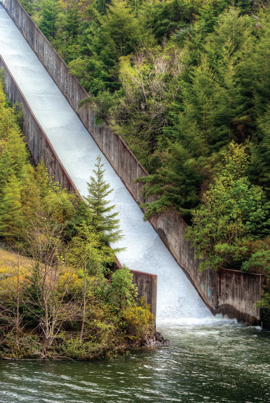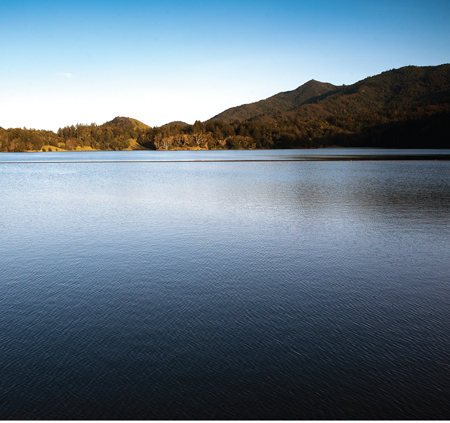Is a desalination plant the answer to Marin’s long-term water needs? The issue has been the center of a contentious debate for more than two decades. Last August, it finally seemed settled when the Marin Municipal Water District approved construction of a $105 million desalination plant near the Richmond–San Rafael Bridge.
But like a Hollywood script under constant rewrite, the story has yet another twist. In April, after a previous year in which residents cut water use by 8.5 percent and a winter of heavy rains overfilled local reservoirs, the district shelved the desalination project—at least for now.
The district, which provides water to 190,000 people in south and central Marin, wants to hold off until it completes a state-mandated assessment of local water supplies that will consider whether they are sufficient in normal, dry and multiple dry years.
The review, done every five years and called the Urban Water Management Plan, will be finished this year. Coupled with this summer’s water use statistics, the study will determine the fate of the desalination plant—all of which makes this year critical in determining Marin’s future water supply.
And that brings us to the $105 million question: with the district’s seven reservoirs brimming and water consumption levels lower than expected, is there still a need for a pricey desalination plant?
That depends on how thirsty the people of Marin get, says Paul Helliker, general manager of the district.
“If the consumption pattern continues, then we don’t have to move ahead,” he says. “But if water use goes back up, then our projections are we won’t have enough water in a future drought.”
Between 2001 and 2005, when the district was in the thick of planning for the desalination plant, its residential and business customers used 1 billion more gallons of water per year than they do now. Today, after conservation efforts by customers, a cool summer and a rotten economy, consumption has fallen—dipping so much last year the district ratcheted up water rates 9.8 percent to cover a $3.9 million drop in revenue.
Now the decision is whether Marin should move forward with the desalination plant as an insurance policy or trust that lower use patterns will persist. If water usage rises again, and Marin doesn’t have another source, such as the desalination plant, the county could find itself unprepared, and very thirsty, when the next drought inevitably occurs.
The Big Drought of ’76
The drought of 1976 is considered Marin’s worst on record. Toilets weren’t flushed, people put buckets in their showers to catch water for their yards and Marin built a temporary pipeline across the Richmond–San Rafael Bridge to pump in water from the East Bay.
 If a similar drought happened today, getting through it would mean more than letting lawns go brown. Many homes already have low-flow toilets and showerheads, landscaping is less water-hungry and people are more conservation conscious, which means saving additional water would be even more difficult. The water district predicts that a ’76-level drought would force residents to cut back water useage 65 percent more—on top of what they’ve already saved.
If a similar drought happened today, getting through it would mean more than letting lawns go brown. Many homes already have low-flow toilets and showerheads, landscaping is less water-hungry and people are more conservation conscious, which means saving additional water would be even more difficult. The water district predicts that a ’76-level drought would force residents to cut back water useage 65 percent more—on top of what they’ve already saved.
It’s a scenario that concerns customers like Alan Peterson, a San Rafael resident who owns a second home on Catalina Island and remembers the water shortage there in the 1970s. “During that time all the restaurants had to serve food on disposable plates because there just wasn’t enough water to wash the dishes,” he says.
Since then, Catalina has built a desalination plant, a solution Peterson endorses. “We will always need to conserve,” he says, “but with the population growing, we need to have some sort of backup. Yes, (the desalination plant) is expensive, but I’d rather pay a little higher water bill than be subject to the inconvenience of having to conserve to a great extent.”
No Easy Answers
A desalination plant alone wouldn’t solve Marin’s water needs if consumption rises and a drought occurs, the water district points out. Initially, the plant could generate five million gallons of water a day, only about one-sixth of Marin’s usage on a hot summer day. The most feasible solution, the district argues, is a combination of desalination and conservation.
Alternate tactics such as increasing the capacity of existing reservoirs or building new ones would be difficult because of environmental concerns involving critical habitat for endangered fish and other aquatic species. Buying Russian River water from the Sonoma County Water Agency (which provides much of the water to Novato via the North Marin Water District) isn’t an option because even if rights to the water could be obtained the cost of constructing more than 50 miles of pipelines and pump stations is prohibitive.
That leaves desalination—a divisive proposition.
Those for and against the plant aren’t split along environmental lines. Some of the local environmental movement’s biggest names support desalination, including Assemblyman Jared Huffman, who pushed the plant as the water district’s only viable source for new water, and nonagenarian environmental activist Marty Griffin, who contends that desalination should be a primary option for meeting Marin’s long-term water needs.
Opponents, such as San Anselmo Councilman Ford Greene, say the plant will “spawn more intense development that we neither want nor need.” Others, such as Mill Valley environmental consultant Geoff Strawbridge, argue that desalination sends the public the wrong message about conservation.
“Coming from a sustainability standpoint, I’m always wary about desalination projects,” Strawbridge says. “It makes it very difficult to help people look at the larger picture.”
How Desalination Works
As a technology, desalination isn’t new. Facilities exist in every U.S. state, and in desert countries such as Saudi Arabia, desalinated seawater makes up almost the entire water supply.
The Marin Municipal Water District built a small pilot desalination plant in the 1990s that it used to test the quality of the water the process would produce. The results? “We did a testing (for) 600-plus chemicals and found very few detectable levels, and none of those come through the treatment system into the drinking water,” Helliker says. The Marin plant would be located on water district land on Pelican Way in San Rafael and would pump in bay water from a nearby intake. The plant would convert the salt water into drinkable water.
The process involves several phases—first removal of solids from the salt water, then desalination via a process called reverse osmosis (see sidebar), and finally post-treatment of the desalted water to make it taste better.
The saltwater pretreatment leaves a sludge that would be disposed of at a regional landfill and the reverse osmosis creates a byproduct of saline concentrate, or brine. The Central Marin Sanitation Agency, which treats wastewater in central Marin, would blend the brine with treated effluent to reduce the salt concentration and pump it back into the bay.
Critics are concerned about the effect of the brine on marine life and about the amount of energy the reverse osmosis requires. Under average conditions for a five-million-gallon-per-day desalination facility, the water district projects a 40 percent increase in electricity usage. In a drought, electricity usage would double.
Changing Behavior, Hoping for Rain
Those are the sorts of issues that desalination opponents say increase the urgency of the case for more conservation.
“There’s a ton of work to be done and ways to be less water wasteful before we have to get into a desal project,” says Strawbridge, who argues that the water district underestimates the full potential for local conservation. “It’s time we looked at the larger picture and see how people can look at water more wisely with education and behavior modification.”
Ultimately, getting people to change their behavior is crucial in order to guarantee sufficient water supply for the long haul, says Brock Dolman, director of the Water Institute in Sonoma. “You’ve got to tighten up the ship,” he says. “Any time you don’t need to use water, don’t use it. Imagine the savings that ripple out of that.”
This is where the big Hollywood cliffhanger comes in: will the county be able to live long term on less water? Even after the district completes its water management analysis and decides whether to desalinate or not, we’ll have to wait for the sequel to find out.
The only certainty, Helliker says, is that if the district ever OKs desalination, it will take five years to get the plant up and running. “We have a two-year water supply when it stops raining, so a five-year window doesn’t give us a warm and fuzzy feeling,” he says. “That’s always the challenge we face—what’s the weather going to hold in store?”
Where the Water Goes
Lather, rinse, don’t repeat. At the Marin Municipal Water District’s lowest-tier billing rate, with a MMWD- and state-required showerhead that uses two gallons per minute, a 10-minute shower costs less than a penny. At the highest-tier rate, the shower costs 54 cents. With an older showerhead that typically uses about four gallons per minute, at the highest-tier rate, the shower costs over a dollar.
Flushing money down the drain? All plumbing installed, replaced or moved in any new or existing MMWD service is required by the district to be high-efficiency. With these types of toilets, at the lowest-tier rate, 10 flushes cost about a half cent; at the highest-tier rate, about 35 cents. With older toilets made pre-1980, the 10-flush cost ranges from 23 cents to $1.36.
Wear again before you wash. High-efficiency clothes washers save water and money. For 10 high-efficiency washes, the cost ranges from 59 cents to $3.54. The cost of doing 10 loads with older, standard washers ranges from $1.77 to $10.60.
So what’s Osmosis—let alone reverse?
This process uses a pressure-driven membrane to separate salt water into drinkable water and brine. The semipermeable membrane allows water passage while limiting the passage of solutes (such as salts and other contaminants). The process requires that the water be applied to the membrane at a pressure that exceeds osmotic pressure—hence the term reverse osmosis.


